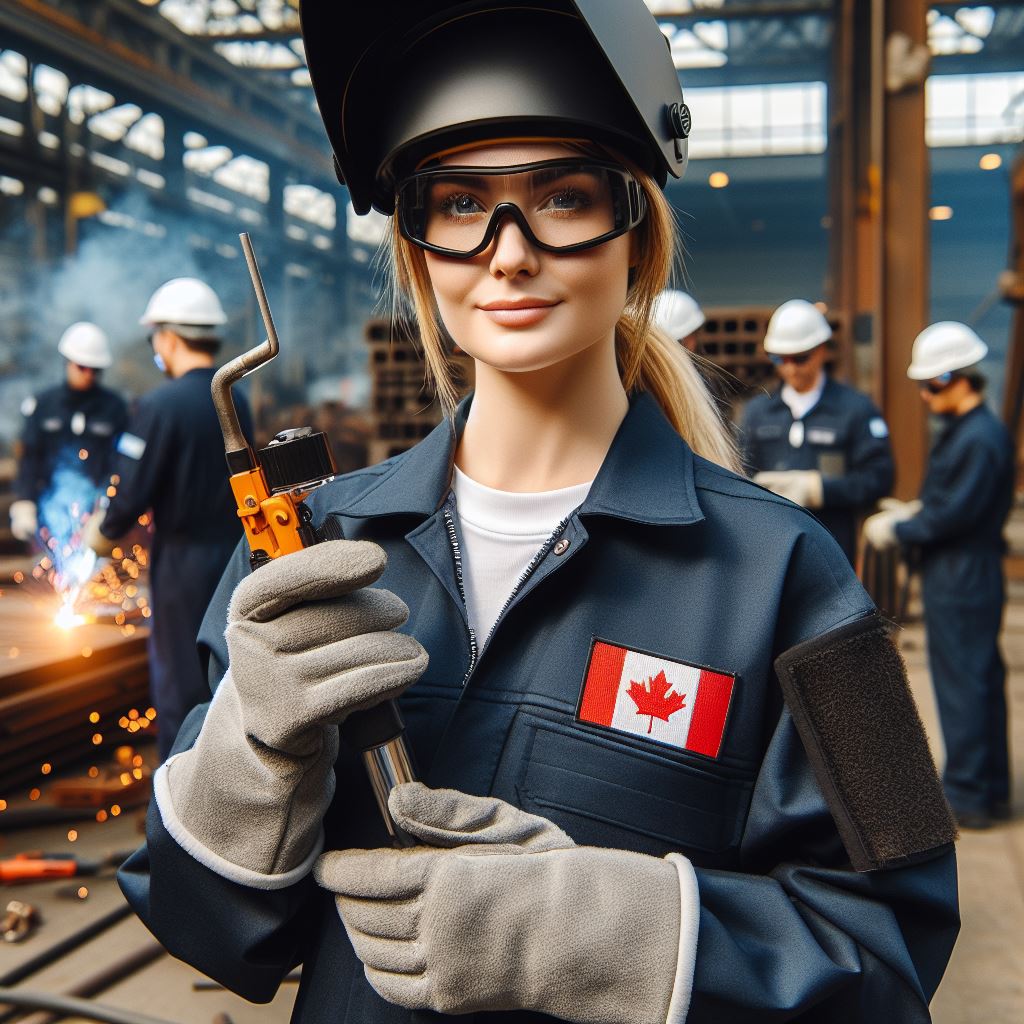Introduction
Welding in harsh Canadian climates requires a special set of skills and techniques.
The extreme cold, heavy snowfall, and strong winds pose significant challenges for welders in Canada.
This blog post will explore the unique challenges faced by welders working in harsh Canadian climates and provide tips for successful welding in these conditions.
Welders in Canada must overcome freezing temperatures, snow accumulation, and unpredictable weather conditions.
The extreme cold affects the welding process, causing cracks and brittleness in the welded joints.
The heavy snowfall can obstruct access to welding sites and create additional safety hazards.
Strong winds make it more challenging to create a stable welding environment and maintain the necessary shielding gas.
To succeed in welding in harsh Canadian climates, welders must take certain precautions and adapt their techniques.
Choosing the right welding equipment that can withstand extreme temperatures is crucial.
Preheating the materials and using special low-temperature electrodes can help overcome the cold-related challenges.
Having proper insulation and protective gear, such as heated clothing and gloves, is essential for welder safety.
Planning the welding process according to weather forecasts and having backup strategies can mitigate the impact of unpredictable weather conditions.
In short, welding in harsh Canadian climates requires specialized knowledge, equipment, and precautions.
By understanding the unique challenges and implementing the necessary techniques, welders can ensure successful outcomes in these conditions.
Importance of Climate in Welding
Explanation of how climate affects welding
In the field of welding, climate plays a crucial role in the success and durability of the welds.
The various weather conditions can significantly impact the welding process, making it imperative for welders to understand and adapt to the climate they are working in.
When it comes to welding, temperature is a critical factor.
Hot or cold climates can affect the performance of welding equipment, including the welder’s ability to control the heat.
In extremely cold conditions, welding becomes more challenging as metals contract and become brittle, making it harder to achieve strong and reliable welds.
On the other hand, extreme heat can cause metals to expand, affecting the fit-up and overall quality of the welds.
Apart from temperature, humidity also plays a significant role. High humidity levels can introduce moisture into the weld zone, leading to the formation of hydrogen molecules.
Hydrogen can cause hydrogen-induced cracking, which weakens the welds’ integrity.
Similarly, excessive moisture can affect the performance of the shielding gas, resulting in poor gas coverage and potential contamination.
Overview of why Canadian climates pose particular challenges
Canadian climates, known for their harshness, present unique challenges for welding professionals.
The country experiences extreme temperatures, ranging from freezing winters to scorching summers. These temperature extremes can pose significant obstacles for welders working in Canada.
Unlock Your Career Potential
Visualize a clear path to success with our tailored Career Consulting service. Personalized insights in just 1-3 days.
Get StartedDuring wintertime, welders must contend with sub-zero temperatures and cold winds that affect equipment performance.
Welding in freezing conditions requires additional precautionary measures, such as preheating the metal, using specialized low-temperature electrodes, and ensuring proper shelter to prevent exposure to frigid air.
Furthermore, Canadian summers bring their own set of challenges.
Welding in hot and humid conditions can lead to overheating of welding machines and decreased electrode efficiency.
The excessive heat can also impact the welder’s comfort and overall safety, making it crucial to have proper ventilation and protective gear.
Importance of understanding and adapting to the climate when welding
Understanding and adapting to the climate are fundamental for welders working in harsh Canadian climates.
By doing so, welders can ensure the quality and longevity of their welds, as well as their own safety.
Firstly, welders need to be aware of the specific challenges posed by the climate they are working in and take appropriate measures.
This includes using temperature-resistant materials, adjusting welding techniques, and employing preheating or cooling methods to compensate for extreme temperatures.
Secondly, adequate preparation is crucial. Welders should regularly monitor weather forecasts to plan their work accordingly.
For instance, welding during milder conditions might be more optimal, as it is easier to control the welding process and ensure proper fusion.
Lastly, preventive maintenance of welding equipment is essential.
Regular inspections and repairs can prevent breakdowns and ensure optimal performance, especially considering the additional stress imposed by harsh climates.
In fact, climate holds immense importance in the field of welding, particularly when working in harsh Canadian climates.
Understanding how temperature and humidity affect the welding process and taking appropriate measures to adapt to these conditions is crucial for achieving strong and reliable welds.
By being well-prepared and maintaining welding equipment, welders can overcome the challenges posed by the climate and ensure successful welding operations in even the harshest Canadian environments.
Read: Exploring the Art of Sculptural Welding
Common Challenges faced by Welders in Harsh Canadian Climates
Welding in harsh Canadian climates is no easy task. Welders face a myriad of challenges that can significantly impact their work outcomes and safety.
In this section, we will explore the common challenges encountered by welders in such conditions.
Extreme temperatures
Extreme temperatures are a major concern for welders working in harsh Canadian climates.
The extreme cold or hot weather affects the metal and the weld pool.
In cold temperatures, the metal contracts, making it more prone to cracking. On the other hand, intense heat can lead to distortion and weakening of the metal.
These temperature variations require welders to carefully monitor and manage their welding parameters to ensure appropriate heat input.
Moreover, extreme temperatures also pose safety concerns for welders.
Working in frigid temperatures increases the risk of hypothermia, while welding in hot conditions can lead to heatstroke.
Adequate protective gear and regular breaks are crucial to minimize the impact of these extreme temperatures on the welders’ health.
High humidity and precipitation
High humidity and precipitation are additional challenges faced by welders in Canada’s harsh climates.
Welding in wet conditions can negatively affect electrode performance.
Moisture can lead to porosity in the weld, compromising its strength and integrity. Additionally, the presence of moisture increases the risk of corrosion in the welded joints.
Regular inspections and proper surface preparation become essential to mitigate these risks.
Strong winds and wind chill
Strong winds add another layer of difficulty for welders in harsh climates.
The gusty winds make it challenging to maintain proper shielding gas coverage, which is crucial for protecting the weld from oxidation and other contaminants.
Inadequate gas coverage can result in weld defects and reduced weld quality.
Welding screens and windbreaks are often used to shield the work area from excessive wind, helping to maintain proper gas coverage.
Furthermore, strong winds combined with low temperatures create wind chill, resulting in a significant drop in the perceived temperature felt by the welder.
This not only creates discomfort but also leads to reduced dexterity and reduced productivity.
Welders must take breaks in heated areas to restore warmth and prevent any adverse effects on their performance.
In review, welders working in the harsh Canadian climates face a range of challenges.
Extreme temperatures can affect the metal and weld pool, while high humidity and precipitation increase the risk of corrosion.
Strong winds pose difficulties in maintaining shielding gas coverage, and wind chill affects welder comfort and productivity.
With proper precautions, welders can overcome these challenges and ensure high-quality welds even in harsh conditions.
Read: Marine Welding Opportunities in Canada

Tips for Successful Welding in Harsh Canadian Climates
Welding in harsh Canadian climates can be a challenging task due to the extreme weather conditions.
However, with the right approach and necessary precautions, successful welding can still be achieved.
This section focuses on providing valuable tips to enhance welding practices and ensure optimal results even in unfavorable environments.
Proper clothing and personal protective equipment (PPE)
A proper choice of clothing and personal protective equipment (PPE) is essential when welding in harsh Canadian climates.
Insulated and fire-resistant clothing should be worn to safeguard against the extreme temperatures commonly experienced.
Additionally, using gloves and headgear provides added protection and ensures the welder’s safety and comfort.
Welding techniques and adjustments
To overcome the challenges posed by cold cracking, preheating materials is highly recommended.
The process of raising the material’s temperature prior to welding helps alleviate the risk of cracking that arises due to the extreme cold.
Furthermore, adjusting welding parameters is crucial to compensate for the harsh temperatures and maintain the desired weld quality.
Storage and handling of materials
Storage and handling of materials play a significant role in ensuring successful welding outcomes.
Moisture absorption can weaken materials, leading to compromised weld quality. Thus, it is important to store materials in dry and controlled environments to prevent such issues.
Additionally, protecting materials from corrosion during transportation and storage is vital to maintain their integrity.
Equipment maintenance and care
Proper maintenance and care of welding equipment are paramount in harsh climates.
Regular inspections and cleaning should be carried out to identify any potential issues and ensure optimal performance.
Additionally, lubricating moving parts and protecting equipment against moisture helps prolong its lifespan and prevent damage that can be caused by extreme weather conditions.
In general, welding in harsh Canadian climates requires adherence to specific guidelines and precautions.
By following the tips outlined in this section , welders can enhance their practices and overcome the challenges imposed by the extreme weather conditions.
With proper clothing, use of PPE, adjustment of welding techniques, efficient storage and handling of materials, and regular maintenance of equipment, successful welding outcomes can still be achieved, even in the harshest of Canadian climates.
Read: Robotic Welding: Canada’s Industrial Future
Case Studies: Welding Success Stories in Harsh Canadian Climates
Real-life examples of welders who have overcome the challenges
- John, a seasoned welder, faced extreme cold temperatures while working on a pipeline project.
- Despite the harsh climate, John used specialized welding techniques and protective gear to ensure quality and safety.
- His determination and expertise allowed him to successfully complete the project, earning him respect in the industry.
- Another example is Sarah, who tackled welding projects in remote areas of Canada with challenging weather conditions.
- She developed customized welding procedures and collaborated with her team to adapt to unpredictable climates.
- Her ability to think on her feet and make quick decisions enabled her team to deliver exceptional results.
- These real-life stories demonstrate the resilience and resourcefulness of welders working in harsh Canadian climates.
The use of innovative techniques or equipment
- In recent years, welding technology has advanced to meet the demands of harsh Canadian climates.
- New equipment like portable heating systems and climate-controlled welding enclosures have improved efficiency.
- These innovations allow welders to maintain optimal working conditions despite extreme cold, wind, or snow.
- Techniques such as preheating materials and using specialized alloys have also proved effective.
- Welders can now achieve stronger and more durable welds in even the most challenging weather.
The importance of adapting and learning from experience
- Welding in harsh Canadian climates requires constant adaptation and learning from past experiences.
- Welders must understand the unique challenges each climate presents and be prepared for unexpected conditions.
- By analyzing past projects, welders can identify areas for improvement and adjust their techniques accordingly.
- Learning from mistakes is crucial in developing effective strategies to combat the difficulties of welding in extreme climates.
- Experienced welders often share their knowledge and mentor less experienced welders, fostering a culture of continuous learning.
In a nutshell, welding in harsh Canadian climates poses significant challenges, but dedicated welders have proven their ability to overcome them.
Real-life examples showcase the ingenuity and determination of welders who prioritize safety and quality in adverse conditions.
The use of innovative techniques and equipment has further enhanced welding capabilities, enabling welders to deliver exceptional results.
Adaptation and continuous learning from experience are crucial in ensuring successful outcomes in extreme climates.
By sharing their knowledge and experiences, welders can inspire future generations and further advance the field of welding in Canada.
Read: Welding in the Canadian Oil and Gas Sector
Conclusion
Welders in harsh Canadian climates encounter extreme temperatures, high winds, heavy precipitation, and corrosive conditions.
Understanding and adapting to the climate is crucial for welders to ensure the quality and durability of their work.
By implementing proper safety measures, selecting suitable materials, and using specialized equipment, welders can excel in challenging Canadian climates.




